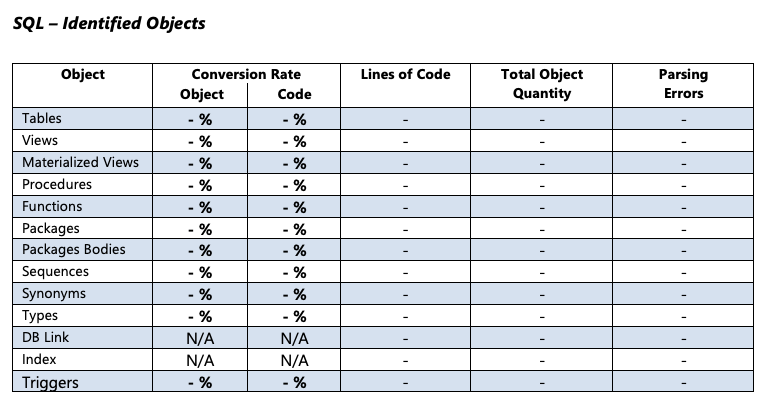SnowConvert AI – Aufschlüsselung auf Datei- und Objektebene – SQL-identifizierte Objekte¶

Conversion Rate - Object¶
Bemerkung
Ein Objekt gilt als erfolgreich migriert, wenn es keine Probleme mit mittlerem, hohem oder kritischem Schweregrad aufweist.
Stellt den Prozentsatz der von SnowConvert AI identifizierten Objekte dar, die erfolgreich migriert wurden. Dies hilft dabei, die Anzahl der Objekte zu ermitteln, die erfolgreich migriert wurden, sowie die Objekte, die manuell bearbeitet werden müssen, um die Migration der Objekte zu Snowflake abzuschließen. Wenn „N/A“ in der Spalte aufgeführt ist, bedeutet dies, dass der Objekttyp in Snowflake nicht unterstützt wird. In dieser Spalte könnte auch „-“ stehen, was bedeutet, dass die von SnowConvert AI migrierten Dateien keine Objekte des spezifischen Typs enthielten, die identifiziert werden konnten.
Formel¶
(successfully_converted_objects / total_object_quantity) * 100
Zu CSV zugeordnete Feldnamen¶
Alle Sprachen
Tables: SqlTableObjectConversionRate
Views: SqlViewObjectConversionRate
Procedures: SqlProcedureObjectConversionRate
Functions: SqlFunctionObjectConversionRate
Triggers: SqlTriggerObjectConversionRate
Indexes: N/A
Teradata
Macros: SqlMacroObjectConversionRate
Join Indexes: SqlJoinIndexObjectConversionRate
Oracle
Packages: SqlPackageObjectConversionRate
Packages Bodies: SqlPBodyObjectConversionRate
Sequences: SqlSequenceObjectConversionRate
Synonyms: SqlSynonymObjectConversionRate
Types: SqlTypeObjectConversionRate
DB Link: N/A
Materialized Views: SqlMaterializedObjectConversionRate
SQLServer
Materialized Views: SqlMaterializedObjectConversionRate
Beispiel¶
-- Table that is migrated successfully to Snowflake.
CREATE TABLE table1 (
col1 INTEGER
);
-- Table that is not migrated successfully to Snowflake because of the data type of col1.
CREATE TABLE table2 (
col1 ANYTYPE
);
Erwartete Objektkonvertierungsrate: 50 %
Erläuterung: Mit dem obigen Beispielcode haben wir eine Objektkonvertierungsrate von 50 %, da nur 1 der 2 identifizierten Tabellen erfolgreich nach Snowflake migriert wurde.
Conversion Rate - Code¶
Stellt den Prozentsatz der Zeilen oder Zeichen des Codes des Objekts der obersten Ebene dar, die erfolgreich migriert wurden. Weitere Informationen zu den verschiedenen Modi der Umwandlungsrate und deren Berechnung durch SnowConvert AIerhalten Sie hier.
Zu CSV zugeordnete Feldnamen¶
Bemerkung
Jedes Objekt der obersten Ebene hat im Bericht Assessment.csv zwei Felder für die Codekonvertierungsrate. Eines ist für die Konvertierungsrate anhand der Codezeilen und das andere für die Konvertierungsrate anhand der Zeichen.
Alle Sprachen:
Tabellen
Lines of Code: SqlTableLoCConversionRate
Characters: SqlTableCharacterConversionRate
Views
Lines of Code: SqlViewLoCConversionRate
Characters: SqlViewCharacterConversionRate
Procedures
Lines of Code: SqlProcedureLoCConversionRate
Characters: SqlProcedureCharacterConversionRate
Functions
Lines of Code: SqlFunctionLoCConversionRate
Characters: SqlFunctionCharacterConversionRate
Indexes
Lines of Code: N/A
Characters: N/A
Triggers
Lines of Code: SqlTriggerLoCConversionRate
Teradata
Macros
Lines of Code: SqlMacroLoCConversionRate
Characters: SqlMacroCharacterConversionRate
Join Indexes
Lines of Code: SqlJoinIndexLoCConversionRate
Characters: SqlJoinIndexCharacterConversionRate
Oracle
Materialized Views
Lines of Code: SqlMaterializedViewLoCConversionRate
Characters: SqlMaterializedViewCharacterConversionRate
Packages
Lines of Code: SqlPackageLoCConversionRate
Characters: SqlPackageCharacterConversionRate
Package Bodies
Lines of Code: SqlPBodyLoCConversionRate
Characters: SqlPBodyCharacterConversionRate
Sequences
Lines of Code: SqlSequenceLoCConversionRate
Characters: SqlSequenceCharacterConversionRate
Synonyms
Lines of Code: SqlSynonymLoCConversionRate
Characters: SqlSynonymCharacterConversionRate
Types
Lines of Code: SqlTypeLoCConversionRate
Characters: SqlTypeCharacterConversionRate
SQLServer
Materialized Views
Lines of Code: SqlMaterializedViewLoCConversionRate
Characters: SqlMaterializedViewCharacterConversionRate
Beispiel¶
CREATE TABLE table1 (
col1 INTEGER
);
CREATE TABLE table2 (
col1 ANYTYPE
);
Erwartete Codekonvertierungsrate: 83,33 %
Erläuterung: Im vorherigen Beispielcode gibt es zwei CREATE TABLE-Anweisungen und SnowConvert AI wird mit Codezeilen ausgeführt, um die Codekonvertierungsrate zu berechnen. table1 wurde erfolgreich migriert, table2 wurde jedoch nicht vollständig migriert. In diesem Fall konnte Zeile 5 des Eingabecodes nicht migriert werden und nur 5 der insgesamt 6 Codezeilen wurden erfolgreich migriert. Diese Berechnung ergibt eine Konvertierungsrate für Tabellen von 83,33 %.
Lines of Code¶
Stellt die Gesamtzahl der Codezeilen dar, die für die identifizierten Objekte der obersten Ebene verwendet wurden. Es ist wichtig zu beachten, dass die Codezeilen des Objekts der obersten Ebene sowie die Kommentare für diese Spalte verwendet werden. Leere Zeilen hingegen werden in dieser Spalte nicht gezählt.
Zu CSV zugeordnete Feldnamen¶
Alle Sprachen
Tables: SqlTableTotalLinesOfCode
Views: SqlViewTotalLinesOfCode
Procedures: SqlProcedureTotalLinesOfCode
Functions: SqlFunctionTotalLinesOfCode
Indexes: SqlIndexTotalLinesOfCode
Triggers: SqlTriggerTotalLinesOfCode
Teradata
Macros: SqlMacroTotalLinesOfCode
Join Indexes: SqlJoinIndexTotalLinesOfCode
Oracle
Packages: SqlPackageTotalLinesOfCode
Packages Bodies: SqlPBodyTotalLinesOfCode
Sequences: SqlSequenceTotalLinesOfCode
Synonyms: SqlSynonymTotalLinesOfCode
Types: SqlTypeTotalLinesOfCode
DB Link: SqlDbLinkTotalLinesOfCode
Materialized Views: SqlMaterializedViewTotalLinesOfCode
SQLServer
Materialized Views: SqlMaterializedViewTotalLinesOfCode
Beispiel¶
-- Hello World
CREATE TABLE table1 (
col1 INTEGER
);
CREATE TABLE table2 (
-- Hello world 2
col1 ANYTYPE
);
Erwartete Anzahl von Codezeilen: 8
Erläuterung: In diesem Fall haben wir 6 Zeilen, die aus dem Code für die CREATE TABLE-Anweisungen stammen, und 2 für Kommentare, die sich innerhalb der Objekte der obersten Ebene befinden.
Total Object Quantity¶
Stellt die Gesamtzahl der Objekte dar, die von SnowConvert AI während der Parsing-Phase identifiziert wurden.
Zu CSV zugeordnete Feldnamen¶
Alle Sprachen
Tables: SqlTableTotalOccurrences
Views: SqlViewTotalOccurrences
Procedures: SqlProcedureTotalOccurrences
Functions: SqlFunctionTotalOccurrences
Indexes: SqlIndexTotalOccurrences
Triggers: SqlTriggerTotalOccurrences
Teradata
Macros: SqlMacroTotalOccurrences
Join Indexes: SqlJoinIndexTotalOccurrences
Oracle
Packages: SqlPackageTotalOccurrences
Packages Bodies: SqlPBodyTotalOccurrences
Sequences: SqlSequenceTotalOccurrences
Synonyms: SqlSynonymTotalOccurrences
Types: SqlTypeTotalOccurrences
DB Link: SqlDbLinkTotalOccurrences
Materialized Views: SqlMaterializedViewTotalOccurrences
SQLServer
Materialized Views: SqlMaterializedViewTotalOccurrences
Beispiel¶
-- Successfully parsed table.
CREATE TABLE table1 (
col1 INTEGER
);
-- Table with a parsing error that could not be identified.
CRATE TABLE table2 (
col1 INTEGER
);
Erwartete Gesamtobjektmenge: 1.
Erläuterung: Eine Tabelle wurde von SnowConvert AI während der Parsing-Phase vollständig analysiert, die andere Tabelle weist aber einen Parsing-Fehler auf, der dazu führt, dass SnowConvert AI sie nicht als Tabellenobjekt identifiziert.
Parsing Errors¶
Stellt die Anzahl der Parsing-Fehler dar, die sich innerhalb der identifizierten Objekte jedes Objekttyps der obersten Ebene befinden.
Zu CSV zugeordnete Feldnamen¶
Alle Sprachen
Tables: SqlTableTotalParsingErrors
Views: SqlViewTotalParsingErrors
Materialized Views: SqlMaterializedViewTotalParsingErrors
Procedures: SqlProcedureTotalParsingErrors
Functions: SqlFunctionParsingErrors
Triggers: SqlTriggerTotalParsingErrors
Indexes: SqlIndexTotalParsingErrors
Teradata
Macros: SqlMacroTotalParsingErrors
Join Indexes: SqlJoinIndexTotalParsingErrors
Oracle
Packages: SqlPackageTotalParsingErrors
Packages Bodies: SqlPBodyTotalParsingErrors
Sequences: SqlSequenceTotalParsingErrors
Synonyms: SqlSynonymTotalParsingErrors
Types: SqlTypeTotalParsingErrors
DB Link: SqlDbLinkTotalParsingErrors
Materialized Views: SqlMaterializedViewTotalParsingErrors
SQLServer
Materialized Views: SqlMaterializedViewTotalParsingErrors
Beispiel¶
-- Table with parsing error but still was identified by SnowConvert.
CREATE TABLE table1 (
col3 NUMBER,
);
-- Table with parsing error but was not identified by SnowConvert.
CRATE TABLE table2 (
col1 INTEGER
);
Erwartete Parsing-Fehler: 1
Erläuterung: In der Spalte Parsing-Fehler wird nur ein Parsing-Fehler gemeldet, da SnowConvert AI nur die erste Tabelle identifizieren konnte. Da die zweite Tabelle nicht identifiziert wurde, werden diese Parsing-Fehler nicht in der Spalte Parsing-Fehler gezählt.